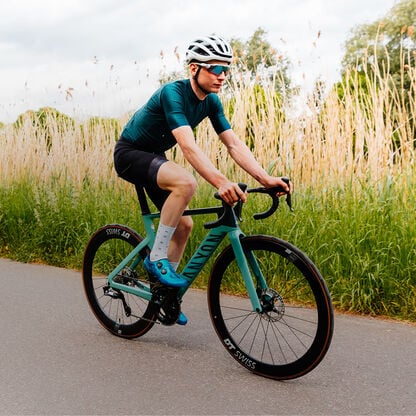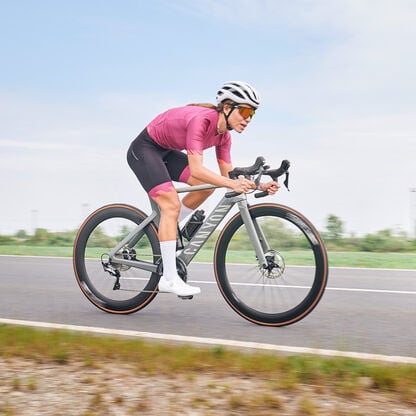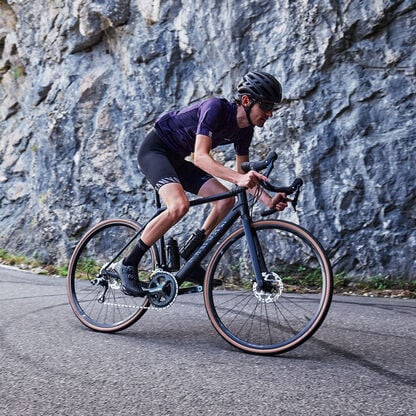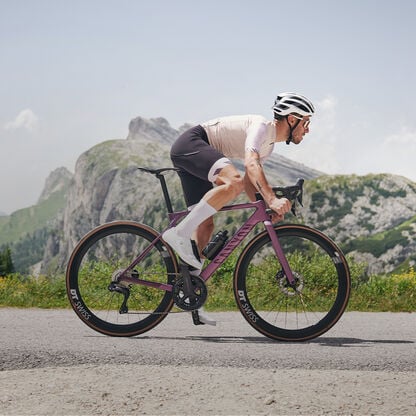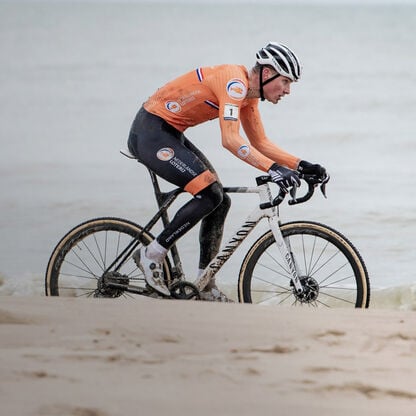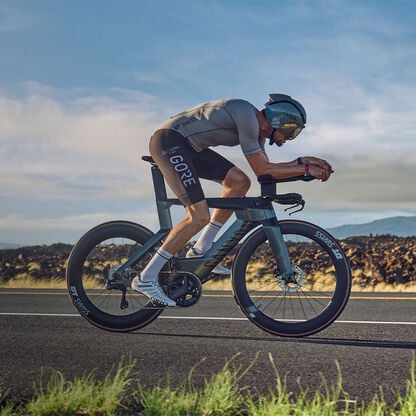Giro d’Italia 2025: Guide to the route, stages, and riders
The 2025 Giro d’Italia is on the horizon! We will cover everything from the race route and key stages to the race’s history, major riders on the start list, and how to watch.
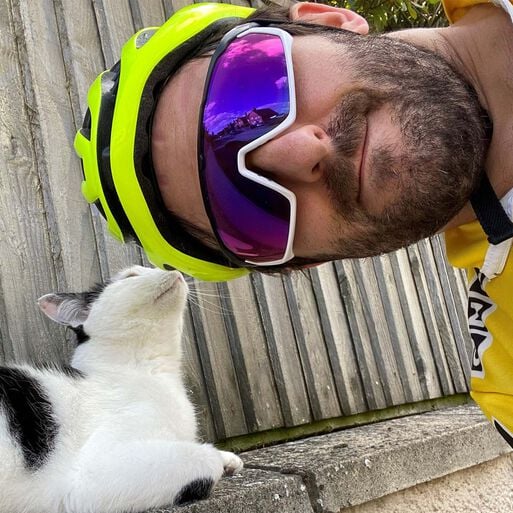
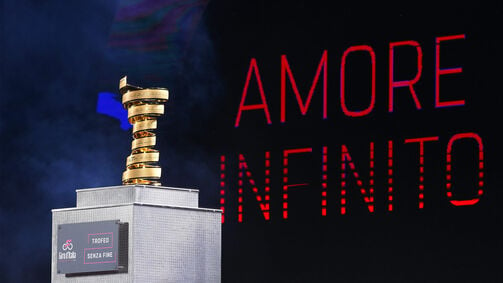
Contents
The Giro d’Italia is one of three Grand Tours in the men’s calendar and precedes the Tour de France and the Vuelta a España.
A 21-day stage race that lasts three weeks, the Giro d’Italia is packed with opportunities for all types of rides, including sprinters and pure climbers, with the GC contenders battling it out for the coveted magalia rosa, which is handed to the rider who leads the overall standings.
This year’s Giro d’Italia will start in Albania for the first time in the race’s history before heading to Italy. It will eventually finish in Rome at the beginning of June.
Widely respected as the most beautiful Grand Tour of the year, the Giro d’Italia will see a star-stunned field take to the start as Primož Roglič looks to become a two-time winner in the absence of last year’s victor, Tadej Pogačar.
Giro d’Italia 2025 in numbers
Race dates: May 9-June 1, 2025
Total distance: 3,413 km
Total distance climbed: 52,500m
Defending champion: Tadej Pogačar
5 summit finishes
6 sprint finishes
2 time trials
Giro d’Italia history
Founded in 1909 by the pink Italian newspaper, La Gazzetta dello Sport, the Giro d’Italia has become one of the biggest and most-loved races in the cycling calendar. One of just three Grand Tours, the race is now run and operated by RCS Sport.
The Giro d’Italia is synonymous with some of cycling’s most memorable moments. From Fausto Coppi destroying the field across five mountain passes on his way to a 1949 Giro win; Eddy Merckx soloing to victory on the Tre Cime di Lavaredo in 1968; Andy Hampsten conquering the Passo di Gavia during an actual blizzard en route to his maglia rosa win in 1988, and Chris Froome’s solo attack in 2018 that netted him his first and only Giro d’Italia thanks to a daring solo ride.
Alfredo Binda, Coppi, and Merckx are the only riders in history to have won the race three times. The fastest edition was in 2024, with an average winner’s speed of 41.866 kph.
When is the Giro d’Italia 2025?
The 108th Giro d’Italia will hold its Grande Partenza in Albania on May 9. After three stages, the three-week Grand Tour will travel from Albania and into Italy for stage 4. The rest of the race will traverse from south to north before concluding in Rome on June 1. The final stage will take place with the Colosseum in the backdrop.

What are the main storylines heading into the 2025 Giro d’Italia?
With defending champion Tadej Pogačar not on the start line this year, the 2025 Giro d’Italia can potentially be one of the most open and closely fought Grand Tours in recent years. Last year, Pogačar dominated the race, winning six stages and never looking like he was in trouble as he cruised to his first maglia rosa.
This year, previous winner Primož Roglič will look to win his second Giro d’Italia title, but he’ll face stiff opposition from Pogačar’s trade teammates Juan Ayuso and Adam Yates.
Antonio Tiberi, Simon Yates, Richard Carpaz, and Egan Bernal could also be in the frame for overall victory. Former winner Nairo Quintana might be past his best, but the Movistar rider will be one to watch in the high mountains.
In the battle for the sprints, Kaden Groves (Alpecin - Deceuninck) and Fernando Gaviria (Movistar) will be racing their Canyon bikes and facing off against the likes of Mads Pedersen and Sam Bennett.
The Giro d’Italia route and five key stages to watch
The 2025 Giro d’Italia route consists of 21 stages and three rest days. The race kicks off in Albania for the first time in the Giro’s history with the opening three stages taking place there before the riders are transported to Italy during the first rest-day. From there, the race re-starts in Lecce for what’s likely the first mass bunch sprint of the race.
The race dives into the Apennines on stage 7 for the first summit finish in Tagliacozzo, and a likely change to the GC standings but an even more important battle awaits on stage 9 with the race heading from Gubbio to Siena, with the peloton taking on 30km of gravel roads made famous by Strade Bianche.
The second week of the Giro includes a mesh of sprint and mountain stages, as well as the second individual time trial of the race but the battle for the maglia rosa will be decided in the super difficult and arduous final week as the race hits the Dolomites, with five of the final six stages all taking place in the mountains.
Stage 19 heads into the Val d'Aosta and sees the race reach the Queen stage of this year’s Giro with close to 5,000m of vertical climbing across five huge ascents as the riders travel from Biella to Champoluc.
The penultimate stage sees the race tackle the infamous Colle delle Finestre, which will be the highest point in this year’s race, before the final ascent of the 2025 Giro d’Italia to Sestirere.
At the end of the three weeks, we'll finally find out the winners of the prized Giro d’Italia jerseys – pink for the overall winner, blue for the mountain classifications winner, purple for the winner of the points classification, and white, won by the best 25 and younger rider on the general classification.
Stage 7
The first time trial on stage 2 of the race will define the early GC battle; however, given that the stage is just over 13km in length, the long-term effects on the Giro d’Italia overall standings will be relatively minimal by the end of the race. Stage 7, however, has the potential to blow the race apart, with the peloton facing the first summit finish of the race as the Giro heads into the Apennines. The stage is 168km long and travels from Castel di Sangro to Tagliacozzo. There’s a climb right from the start with the ascent to Roccaraso, and although the gradients ease, there are two important climbs midway through the stage before the final 12.6km to the finish. The last 3km are particularly steep, with pitches over 10 percent. This stage might not tell us who will win the Giro d’Italia, but it will reveal who is no longer in contention.
Stage 9
This has the potential to be the most memorable stage of the Giro d’Italia and certainly the most beautiful, as the race journeys from Gubbio to Siena, tackling five sectors of the iconic dirt roads that make the one-day Classic Strade Bianche a beloved event on the cycling calendar. The sectors vary in difficulty and length, with the most challenging being the climb to San Martino. Weather conditions could significantly influence the outcome of the stage, with wet roads creating a greater sense of chaos. This will be a tough stage for the peloton to manage, and the GC riders will remain on high alert as they ascend toward the finish at Piazza del Campo. Last year, Movistar’s Pelayo Sánchez won the Giro d’Italia gravel stage aboard a Canyon.
Stage 10
The second individual time trial may not be the most exhilarating spectacle of the 2025 Giro d’Italia, but the 28.6km test between Lucca and Pisa could be a pivotal moment in the race. The majority of the course is flat, except for a gentle uphill section in the middle, and the time trial specialists will be vying for victory. It’s also an opportunity for the GC riders with strong time trial skills to put the pure climbers under significant pressure before the mountain stages resume. The gaps between some of the GC favourites could exceed a minute, and while that can be rapidly regained in the mountains, it’s still a formidable challenge.
Stage 19
Purists will be enraged that we haven't included the stage covering both the Passo del Tonale and Mortirolo, but both climbs on stage 17 come too soon before the finish. Stage 19, on the other hand, is packed with immense climbs and concludes with one of the toughest summit finishes of the race. This is the Queen stage of the Giro d’Italia, featuring riders tackling 166km between Biella and Champoluc.
There are five climbs on the menu, starting with the Croce Sera before the long valley road, followed by three consecutive climbs: Col Tzecore, Col Saint-Pantaléon, and Col de Joux. After a brief descent, the race faces the final challenge with the Antagnod climb. Though it’s not a summit finish, as 5km follow the peak of this final test, this stage encompasses 4.950m of climbing and will see riders finishing in ones and twos
Stage 20
With the final stage in Rome set to conclude with a bunch sprint, stage 20 will decisively determine the overall outcome of the Giro d’Italia. Similar to the efforts of the previous day, this stage will focus on the pure climbers and GC stars as they battle it out for the final maglia rosa and podium positions. The 203km route from Verrès to Sestirere includes four categorized climbs. The initial one at Corlo serves as a brief leg-warmer before the second-category ascent to Colle del Lys. There’s a short respite before the race reaches the highest point of the Giro d’Italia at Colle delle Finestre, with the final climb to Sestirere following shortly after.

Canyon riders to watch
Although Mathieu van der Poel is set to skip the Giro d’Italia this year, there are still plenty of Canyon athletes to cheer at the race. Kaden Groves is expected to return and lead the line in van der Poel’s absence. The Australian sprinter will be gunning for stages on his Canyon Aeroad CFR, and could be a contender for the points classification.
Fernando Gaviria will be one of the sprinters competing against Groves. The 30-year-old has won five Giro stages in the past and claimed the points classification in 2017. Like Groves, the Colombian will be piloting a Canyon Aeroad CFR in the sprints for Movistar.
The Spanish team also return with Nairo Quintana and Davide Formolo, who are aiming for stages in the mountains aboard Canyon’s Aeroad. Pelayo Sánchez is another rider worth watching within Movistar, along with top-ten contender Einer Rubio.
How to watch the Giro d’Italia
The 2025 Giro d’Italia will be streamed on TNT and Discovery+ in Europe, while Flo Bikes in North America and SBS on Demand in Australia will provide coverage. Complete race plans for those broadcasters have yet to be confirmed.
Follow Canyon on X, Facebook and Instagram for alerts on important stories and action from the spring classics.
Discover our Road Bikes
Did this article help?
Thank you for your feedback
-
 About the author
About the authorDaniel Benson
Get ready to take a thrilling ride through the world of cycling with Daniel Benson, a seasoned journalist who has covered some of the biggest events in the sport, from the Tour de France to the Olympics.
